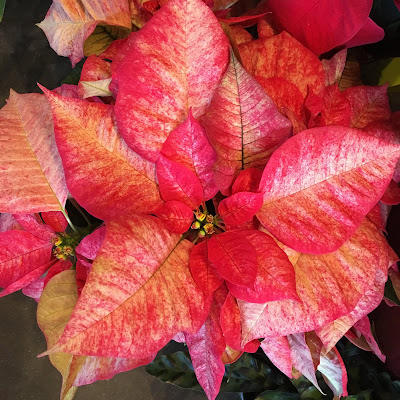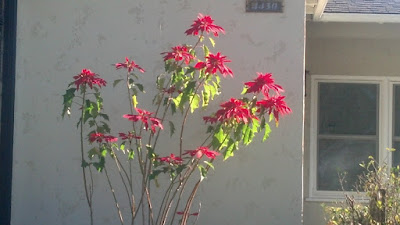
|
|
This poinsettia is among locally grown plants offered at The Plant Foundry.
(Photo courtesy The Plant Foundry)
|
Locally grown, potted poinsettias can last for weeks
Poinsettias have brightened Sacramento Christmases for generations. Most of these locally purchased holiday plants grew up in Auburn.
Eisley Nursery, a family-run business for 86 years, annually supplies about 20,000 poinsettias to other area nurseries and stores. It also sells thousands of foil-wrapped poinsettias at its location, 380 Nevada St., Auburn. (Get directions at
http://www.eisleynursery.com
.)
That local source means these plants didn’t have to travel far to reach our homes. Less stressed, they’re fresher and last longer.
Poinsettias have always been a California thing. In San Diego County, the Ecke family started the tradition of potted poinsettia cuttings almost a century ago. Before that, poinsettias became a popular cut flower in Mexico and Southern California.
A native of Mexico, the poinsettia is actually a frost-tender shrub, a member of the Euphorbia family. In protected areas and coastal communities, they can grow in the ground and produce bountiful blooms for decades. The flowers – actually colorful bracts – appear in late November at the end of long canes. These unusual shrubs often reach 6 to 10 feet tall, creating their own distinctive holiday displays. Any hint of frost causes them to drop most of their foliage, leaving the bright red bracts at the end of near naked canes.
Holiday blooms in pots are grown from cuttings, started in summer and pampered in greenhouses for months. They have a sweet spot: 60 to 70 degrees. Once they find it, they stay good looking for weeks.
Their bloom cycle is tied to darkness; too much light makes them drop their bracts, too.

|
|
If conditions are right, a poinsettia can grow into a large shrub.
(Photo: Debbie Arrington)
|
The University of Illinois Extension compiled loads of poinsettia tips for “The Poinsettia Pages,” the best online resource for indoor poinsettia care. (Find it here:
http://extension.illinois.edu/poinsettia/index.cfm
.) Start with the right plant.
Purchase a poinsettia with dark green leaves all the way to the soil line; it still has all its foliage. That’s a good sign of freshness; skip plants with yellowed or many missing leaves. Avoid any that look wilted, dried out or overly wet.
Also, look at the actual flowers – the little nubs in the center of the bloom. The flowers should be green or red and look fresh. If already yellow and covered with pollen, those flowers mean the poinsettia’s days are numbered.
Here are more tips from The Poinsettia Pages:
* Take off the foil or paper wrapping; it traps too much water around the roots. Poinsettias need good drainage and don’t like standing in water. Put a saucer under the pot and, after watering, drain any excess.
* Treat poinsettias like Goldilocks; they want it just right. Exposure to temperatures below 50 degrees, even for a few minutes, can cause leaf drop. Consider that before creating outdoor displays; they’ll last one night.
* Inside, find a spot with indirect light for six hours a day, away from drafts or forced heat. Poinsettias like days in the 60s; slightly cooler (55 degrees) and dark at night.
* Poinsettias prefer soil on the dry side, but don’t let it completely dry out. Feel the soil daily and water when needed.
* After bloom, poinsettias can be fed a balanced liquid fertilizer to prompt new growth. If kept comfortable, they may rebloom next year.


